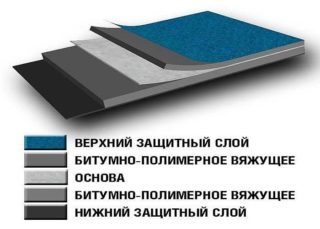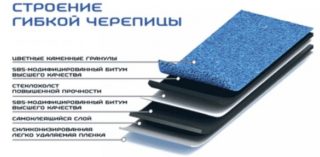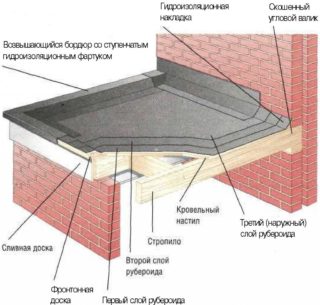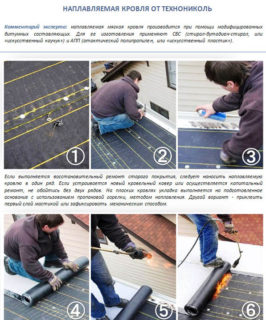A number of requirements are imposed on the roof of a building, the main of which is tightness. One of the options to achieve this quality is a welded roof. This type of coverage is applied to buildings with flat roofs, where there are no slopes and slopes, and the drainage of water is carried out through internal drainage systems. The used roll roofing, installation technology is simple and reliable. To achieve a high-quality result, you need to study the properties of the materials on the market, make the right choice and familiarize yourself with the installation rules.
What is a guided roof
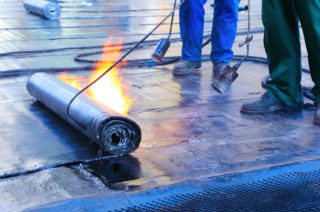
A flat roof is a simple, quick and effective solution for private and industrial construction. Laying one or more slabs on load-bearing walls does not take much time. The finished structure is much cheaper than the truss structures, not inferior to them in functionality and performance. However, traditional coatings - slate, tile and corrugated board - are not suitable for waterproofing a flat surface. Fusion-bonded roofing materials are the only option. They are rolled strips that change properties when heated strongly.
Structurally, the coating consists of a dense base, coated on both sides with binding polymeric or bituminous substances. A layer of stone chips, sand or polyethylene film is applied to the upper part of the strips, which protects the material from contamination and mechanical damage.
The most popular among private developers is the TechnoNIKOL surfacing roof, which can be laid on the bases of this type:
- reinforced concrete floor slabs after sealing and leveling joints;
- thermal insulation boards made of mineral wool;
- screeds made from cement-based mixtures;
- coatings that include asphalt and polymer fillers;
- prefabricated slabs assembled from sheets of asbestos-cement, glass-magnesium and refractory chipboard.
Modern deposited products can be used not only for home decoration. They are used in the construction of foundations, drainage systems, tunnels and bridges. The coating has excellent insulating properties, strength and durability.
Types of base, binder and dressing
Modern build-up roofing material provides the following qualities:
- protection of the building from precipitation;
- prevention of hypothermia and overheating of supporting structures;
- absolute tightness;
- sufficient strength to mechanical stress;
- shape retention with temperature drops;
- elasticity and flexibility;
- long service life;
- ease of installation and repair;
- no need for regular maintenance.
Previously, thick cardboard was used for the manufacture of roofing material, today it has been replaced by more technological materials.
- Polyester. Consists of randomly located polymer fibers. It can stretch by 50% without damage, has a tensile strength of up to 40 kg / cm. Well suited for equipment on difficult and curved surfaces.
- Fiberglass. It is a woven fabric made of flexible glass threads.Possesses high strength (up to 100 kg / cm) and almost complete absence of the ability to stretch.
- Fiberglass. Consists of pressed glass fibers. Differs in sufficient strength, limited flexibility and lack of elongation.
There are other modifications as well. One of them is artificial rubber (SBS). The material has excellent adhesion, remains flexible and tough at the lowest temperatures. SBS coatings are more often used in cold climates.
Another innovative binder is synthetic plastic (APP - atactic polypropylene). The material is resistant to extreme high temperatures, ultraviolet light, has sufficient flexibility and elasticity. It is recommended for use in areas with hot and sunny climates.
The device of the overlaid roof
For different cases, a coverage with a specific structure is selected:
- Single layer. Consists of the minimum amount of material sufficient to insulate the structure. Has a base layer, astringent and protective applications. It is used for the arrangement of buildings, where the periodic movement of only service personnel is provided.
- Multi-layered. Products of this type are characterized by increased strength, flexibility and elasticity. It can withstand heavy loads and even impacts without consequences. The base consists of the same or different types of fabric, between which there is a shock-absorbing polymer pad. The installation is carried out above the technical floors of high-rise buildings and in other places of increased cross-country ability.
If the coating is compatible with each other, it is possible to weld both types on the same roof, varying it in places of high and low load. This method will save money without losing quality.
Do-it-yourself guided roofing technology
The technology of installing a flexible roll roof consists of several sequentially performed stages that involve the use of a small amount of tools and equipment. It is imperative to study and follow the manufacturer's instructions.
For work you will need:
- gas-burner;
- roulette;
- level;
- putty knife;
- roofing knife;
- pressure roller;
- metal brush;
- paint brush;
- deep penetration primer;
- protective equipment for skin, eyes and respiration.
- Carrying out calculations, drawing up a stacking scheme, determining the amount of required material.
- Survey of the surface, removal of protruding fragments - pipes, antennas, anchors, reinforcement and concrete overlays. Cutting and rounding of sharp and right angles on parapets. Cleaning the surface from dirt, grease and oil stains.
- Leveling the base with M150 cement mortar. Surface treatment with deep penetration primer.
- After the surface has dried, final cleaning of dust. For this, a vacuum cleaner, brushes, a compressor, a damp cloth are used.
- Checking the substrate for moisture levels. For this, an electronic hygrometer or determination of the presence of condensation under the laid plastic wrap is used. Reducing moisture is achieved by drying with a building hair dryer or wiping with acetone.
- Base primer with bituminous primer.Marking.
- Placing the first roll, unrolling it so that it straightens and wrinkles disappear. Securing the initial edge of the strip by heating it and pressing it to the base. After that, the roll is rolled up.
- Gradual melting of the binder and primer with a burner. Connecting the strip to the slab, pressing and rolling with a roller.
- The installation of subsequent panels is carried out in the same way. In this case, an overlap of 8-15 cm is made.
- Reinforcement of gutters with cover squares with sides up to 80 cm.
- Placing the edges of the panels on the parapets so that they descend on their outer walls by 25-30 cm.
In conclusion, the quality of the installation is checked.
When material lags are detected, it rises, reheating is done and the strip is pressed with a roller.
Popular product manufacturers
Experts recommend the following grades of overlaid roof:
- TechnoNIKOL;
- Icopal;
- Safety SBS;
- Shinglas;
- Armokrov;
- Ruukki;
- Rubimast;
- Velis;
- Petroflex.
In order not to buy a fake, you need to buy the product in specialized outlets after checking the certificate of conformity from the manufacturer.

